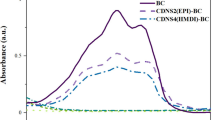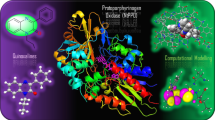Abstract
Molecular interactions of ferrocenyl hydrazones (FcHZ) inclusion complexes with β-cyclodextrin (BCD), methyl-β-cyclodextrin (MEB), 2,6-di-O-methyl-β-cyclodextrin (DIMEB) and 2,3,6-tri-O-methyl-β-cyclodextrin (TRIMEB) in order to enhance their aqueous solubility and anti-mycobacterial efficiency were investigated by semi-empirical PM7 method and B3LYP/m6-31G* calculations. Simulation results suggest the complex formations of FcHZ with BCD, MEB, DIMEB and TRIMEB are possible with 1:1 host–guest molecular ratio. Two different binding modes of the FcHZ inside the BCD and MEB cavities were found. The ferrocene fragment of FcHZ molecule was entrapped in the cavity, located near the wider rim of BCD and MEB in both orientations (A and B). The hydrazone aromatic fragment of FcHZ cannot be completely embedded inside the hydrophobic cavity of BCD. It points downward from the narrower rim of BCD in orientation A and point upward from the wider rim of BCD in orientation B. Only orientation B was found in 1:1 inclusion complex of FcHZ agents with DIMEB and TRIMEB due to the effect of methyl group substitutions at the primary hydroxyl groups, which located at the narrower rim of cyclodextrins. The entering pathways of the FcHZ molecule into the molecular cavity of the BCD, MEB, DIMEB and TRIMEB were also discussed.










Similar content being viewed by others
References
Maguene, G.M., Jakhlal, J., Ladyman, M., Vallin, A., Ralambomanana, D.A., Bousquet, T., Maugein, J., Lebibi, J., Pélinski, L.: Synthesis and antimycobacterial activity of a series of ferrocenyl derivatives. Eur. J. Med. Chem. 46, 31–38 (2011)
Mahajan, A., Kremer, L., Louw, S., Guéradel, Y., Chibale, K., Biot, C.: Synthesis and in vitro antitubercular activity of ferrocene-based hydrazones. Bioorg. Med. Chem. Lett. 21, 2866–2868 (2011)
Davis, M.E., Brewster, M.E.: Cyclodextrin-based pharmaceutics: past, present and future. Nat. Rev. Drug. Discov. 3, 1023–1035 (2004)
Szente, L., Szeman, J.: Cyclodextrins in analytical chemistry: host–guest type molecular recognition. Anal. Chem. 85, 8024–8030 (2013)
Lebrilla, C.B.: The gas-phase chemistry of cyclodextrin inclusion complexes. Acc. Chem. Res. 34, 653–661 (2001)
Crini, G.: Review: a history of cyclodextrins. Chem. Rev. 114, 10940–10975 (2014)
Song, L.X., Bai, L., Xu, X.M., He, J., Pan, S.Z.: Inclusion complexation, encapsulation interaction and inclusion number in cyclodextrin chemistry. Coord. Chem. Rev. 253, 1276–1284 (2009)
Caira, M.R.: Structural aspects of crystalline derivatized cyclodextrins and their inclusion complexes. Curr. Org. Chem. 15, 815–830 (2011)
Miranda, J.C., Martins, T.E.A., Veiga, F., Ferraz, H.G.: Cyclodextrins and ternary complexes: technology to improve solubility of poorly soluble drugs. Braz. J. Pharm. 47, 665–681 (2011)
Saokham, P., Muankaew, C., Jansook, P., Loftsson, T.: Solubility of cyclodextrins and drug/cyclodextrin complexes. Molecules 23, 1161 (2018)
Dandawate, P., Vemuri, K., Khan, E.M., Sritharan, M., Padhye, S.: Synthesis, characterization and anti-tubercular activity of ferrocenyl hydrazones and their β-cyclodextrin conjugates. Carbohyd. Polym. 108, 135–144 (2014)
Leelananda, S.P., Lindert, S.: Computational methods in drug discovery. Beilstein J. Org. Chem. 12, 2694–2718 (2016)
Fukunishi, Y., Mashimo, T., Misoo, K., Wakabayashi, Y., Miyaki, T., Ohta, S., Nakamura, M., Ikeda, K.: Miscellaneous topics in computer-aided drug design: synthetic accessibility and GPU computing, and other topics. Curr. Pharm. Des. 22, 3555–3568 (2016)
Jitapunkul, K., Poachanukoon, O., Hannongbua, S., Toochinda, P., Lawtrakul, L.: Simulation study of interactions between two bioactive components from zingiber cassumunar and 5-lipoxygenase. Cell. Mol. Bioen. 11, 77–89 (2018)
Srihakulung, O., Maezono, R., Toochinda, P., Kongprawechnon, W., Intarapanich, A., Lawtrakul, L.: Host-guest interactions of plumbagin with β-cyclodextrin, dimethyl-β-cyclodextrin and hydroxypropyl-β-cyclodextrin: Semi-empirical quantum mechanical PM6 and PM7 methods. Sci. Pharm. 86, 20 (2018)
Mohammadi, N., Ganesan, A., Chantler, C.T., Wang, F.: Differentiation of ferrocene D5d and D5h conformers using IR spectroscopy. J. Organomet. Chem. 713, 51–59 (2012)
Islam, S., Wang, F.: The d-electrons of Fe in ferrocene: exceed orbital energy spectrum (EOES). RSC Adv. 5, 11933–11941 (2015)
Mitin, A.V., Baker, J., Pulay, P.: An improved 6–31G* basis set for first-row transition metals. J. Chem. Phys. 118, 7775–7782 (2003)
Martin, J., Baker, J., Pulay, P.: Comments on the molecular geometry of ferrocene: the dangers of using quantum chemistry programs as black boxes. J. Comput. Chem. 30, 881–883 (2009)
Meng, X.Y., Zhang, H.X., Mezei, M., Cui, M.: Molecular docking: a powerful approach for structure-based drug discovery. Curr Comput Aided Drug Des. 7, 146–157 (2011)
Stewart, J.J.P.: Optimization of parameters for semiempirical methods VI: more modifications to the NDDO approximations and re-optimization of parameters. J. Mol. Model. 19, 1–32 (2013)
Becke, A.D.: Density-functional thermochemistry. III. The role of exact exchange. J. Chem. Phys. 98, 5648–5652 (1993)
Tirkey, V., Mishra, S., Dash, H.R., Das, S., Nayak, B.P., Mobin, S.M., Chatterjee, S.: Synthesis, characterization and antibacterial studies of ferrocenyl and cymantrenyl hydrazone compound. J. Organomet. Chem. 732, 122–129 (2013)
Steiner, T., Koellner, G.: Crystalline β-cyclodextrin hydrate at various humidities: fast, continuous, and reversible dehydration studied by x-ray diffraction. J. Am. Chem. Soc. 116, 5122–5128 (1994)
Pitha, J., Harata, K.: CCDC 144261: experimental crystal structure determination. CCDC (2004). https://doi.org/10.5517/cc4v3ln
Aree, T., Hoier, H., Schulz, B., Reck, G., Saenger, W.: Novel type of thermostable channel clathrate hydrate formed by heptakis(2,6-di-O-methyl)-β-cyclodextrin⋅15 H2O—a paradigm of the hydrophobic effect. Angew. Chem. Int. Ed. 39, 897–899 (2000)
Caira, M.R., Bourne, S.A., Mhlongo, W.T., Dean, P.M.: New crystalline forms of permethylated β-cyclodextrin. Chem. Commun. 19, 2216–2217 (2004)
Dassault Systèmes BIOVIA: Discovery Studio 4.0 Visualizer. Dassault Systèmes, San Diego (2013)
Frisch, M.J., Trucks, G.W., Schlegel, H.B., Scuseria, G.E., Robb, M.A., Cheeseman, J.R., Scalmani, G., Barone, V., Petersson, G.A., Nakatsuji, H., Li, X., Caricato, M., Marenich, A.V., Bloino, J., Janesko, B.G., Gomperts, R., Mennucci, B., Hratchian, H.P., Ortiz, J.V., Izmaylov, A.F., Sonnenberg, J.L., Williams-Young, D., Ding, F., Lipparini, F., Egidi, F., Goings, J., Peng, B., Petrone, A., Henderson, T., Ranasinghe, D., Zakrzewski, V.G., Gao, J., Rega, N., Zheng, G., Liang, W., Hada, M., Ehara, M., Toyota, K., Fukuda, R., Hasegawa, J., Ishida, M., Nakajima, T., Honda, Y., Kitao, O., Nakai, H., Vreven, T., Throssell, K., Montgomery, J.A., Jr., Peralta, J.E., Ogliaro, F., Bearpark, M.J., Heyd, J.J., Brothers, E.N., Kudin, K.N., Staroverov, V.N., Keith, T.A., Kobayashi, R., Normand, J., Raghavachari, K., Rendell, A.P., Burant, J.C., Iyengar, S.S., Tomasi, J., Cossi, M., Millam, J.M., Klene, M., Adamo, C., Cammi, R., Ochterski, J.W., Martin, R.L., Morokuma, K., Farkas, O., Foresman, J.B., Fox, D.J.: Gaussian 16, Revision C.01. Gaussian, Inc., Wallingford CT, 2016.
Pritchard, B.P., Pritchard, P., Altarawy, D., Didier, B., Gibson, T.D., Windus, T.L.: New basis set exchange: an open, up-to-date resource for the molecular sciences community. J. Chem. Inf. Model. 59, 4814–4820 (2019)
Morris, G.M., Huey, R., Lindstrom, W., Sanner, M.F., Belew, R.K., Goodsell, D.S., Olson, A.J.: Autodock4 and AutoDockTools4: automated docking with selective receptor flexibility. J. Comput. Chem. 30, 2785–2791 (2009)
Morris, G.M., Goodsell, D.S., Halliday, R.S., Huey, R., Hart, W.E., Belew, R.K., Olson, A.J.: Automated docking using a lamarckian genetic algorithm and an empirical binding free energy function. J. Comput. Chem. 19, 1639–1662 (1998)
Acknowledgements
This study was supported by Thammasat University Research Fund, Contract No. TUFT 13/2562. Srihakulung, O. was supported by SIIT-JAIST dual degree scholarship from the National Electronics and Computer Technology Center (NECTEC), Sirindhorn International Institute of Technology (SIIT), and Japan Advanced Institute of Science and Technology (JAIST).
Funding
Lawtrakul, L. was supported by Thammasat University Research Fund, Contract No. TUFT 13/2562. Srihakulung, O. was supported by SIIT-JAIST dual degree scholarship from the National Electronics and Computer Technology Center (NECTEC), Sirindhorn International Institute of Technology (SIIT), and Japan Advanced Institute of Science and Technology (JAIST).
Author information
Authors and Affiliations
Corresponding author
Ethics declarations
Conflicts of interest
None.
Additional information
Publisher's Note
Springer Nature remains neutral with regard to jurisdictional claims in published maps and institutional affiliations.
Rights and permissions
About this article
Cite this article
Srihakulung, O., Triamchaisri, N., Toochinda, P. et al. Theoretical study on ferrocenyl hydrazones inclusion complexes with β-cyclodextrin and its three methylated derivatives. J Incl Phenom Macrocycl Chem 98, 79–91 (2020). https://doi.org/10.1007/s10847-020-01011-z
Received:
Accepted:
Published:
Issue Date:
DOI: https://doi.org/10.1007/s10847-020-01011-z




